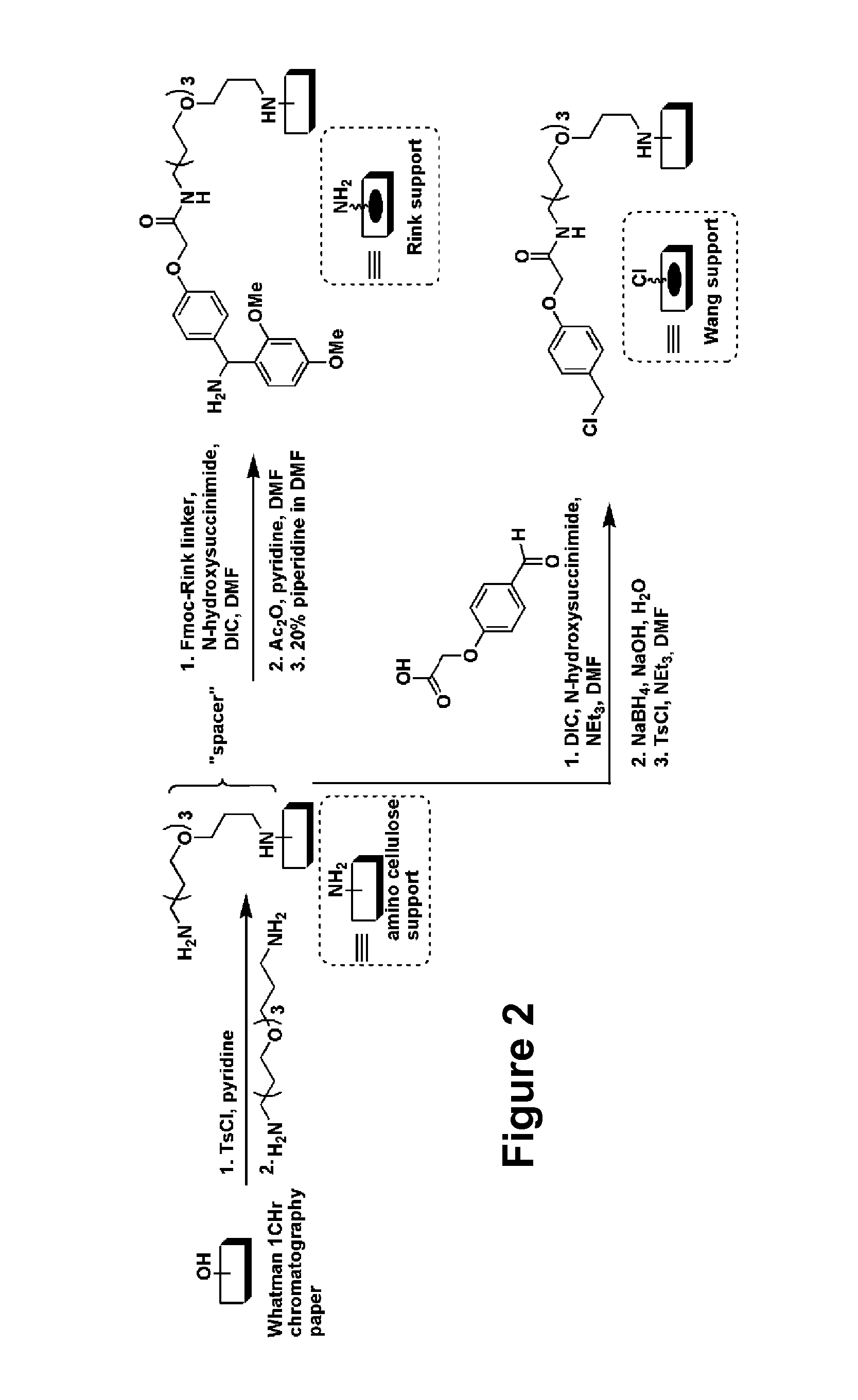Antibacterial small molecules and methods for their synthesis
a small molecule and antibacterial technology, applied in the field of small molecule antibacterial and methods for their synthesis, can solve the problems of uncompatibility of many hydrophobic polystyrene beads, serious medical problems, etc., and achieve the effects of enhancing the biological activity of small molecules, enhancing the diversity of molecules, and enhancing the water-solubility of small molecules
- Summary
- Abstract
- Description
- Claims
- Application Information
AI Technical Summary
Benefits of technology
Problems solved by technology
Method used
Image
Examples
example 1
Synthesis of Libraries Employing Rink Linkers
[0184]FIG. 1 illustrates a general schematic of small molecule macroarray library construction and screening. In order to improve coupling efficiency of the initial building blocks and expand the set of possible building blocks used in library construction, we chose to explore the use of the well-characterized Rink-amide linker system. Bernatowicz, M. S.; Kearney, T.; Neves, R. S.; Koster, H., An Efficient Method for Racemization Free Attachment of 9-Fluorenylmethyloxycarbonyl-Amino Acids to Peptide-Synthesis Supports. Tetrahedron Lett. 1989, 30, 4341-4344; Rink, H., Solid-phase synthesis of protected peptide fragments using a trialkoxy-diphenyl-methyl ester resin. Tetrahedron Lett. 1987, 28, 3787-90. FIG. 2 illustrates the generation of the Rink linker on planar cellulose substrate (e.g., chromatography paper). The figure shows a comparison to the Wang linker used in previous work (WO08 / 016,738).
[0185]It was reasoned that the use of this...
example 2
Solution Phase Synthesis of Rink Acetophenones and Rink Chalcones
[0194]As previously discussed, the acetophenones used in macroarray construction required a carboxylic acid functionality for attachment to the Rink amide linker. To efficiently install this moiety, a general synthetic scheme was designed to derivatize a variety of acetophenones (Scheme 1). An acetophenone was reacted with methyl bromo acetate in the presence of potassium carbonate (K2CO3), and the product was isolated by precipitation from water. Hydrolysis of the ester with NaOH in H2O / THF afforded the acetyl-phenoxyacetic acid carboxylic acid in excellent purity.
[0195]
[0196]In order to estimate the loadings of individual macroarray members, the corresponding acetophenones were cleaved from the macroarray and analyzed by HPLC analysis. An accurate calibration curve was needed for each acetophenone building block to estimate the loading of each macroarray member. Initial attempts at solid phase synthesis of the desire...
example 3
Lead Compound Re-synthesis
[0198]Once active compounds had been identified in the biological assays (as described under Aim 2), they were synthesized in solution to obtain an authentic sample for characterization and further biological evaluation. As some of the active chalcones were similar in structure to our previously reported active chalcones synthesized with the Wang linker43, our initial synthetic route was aimed at generating the chalcone first, followed by an SN2 reaction with 2-bromoacetamide. Although this short synthesis allowed us to obtain the desired chalcone in sufficient quantities after several re-crystallizations, an alternate synthesis was devised to increase reaction yields and decrease purification time.
[0199]
[0200]We found that our solution-phase synthesis of Rink acetophenones could be modified to yield our target chalcones in moderate yields and high purities (Scheme 2). The high purities were attributed to the careful choice of solvent used in the Claisen-Sc...
PUM
| Property | Measurement | Unit |
|---|---|---|
| temperatures | aaaaa | aaaaa |
| temperature | aaaaa | aaaaa |
| diameter | aaaaa | aaaaa |
Abstract
Description
Claims
Application Information
 Login to View More
Login to View More - R&D
- Intellectual Property
- Life Sciences
- Materials
- Tech Scout
- Unparalleled Data Quality
- Higher Quality Content
- 60% Fewer Hallucinations
Browse by: Latest US Patents, China's latest patents, Technical Efficacy Thesaurus, Application Domain, Technology Topic, Popular Technical Reports.
© 2025 PatSnap. All rights reserved.Legal|Privacy policy|Modern Slavery Act Transparency Statement|Sitemap|About US| Contact US: help@patsnap.com



